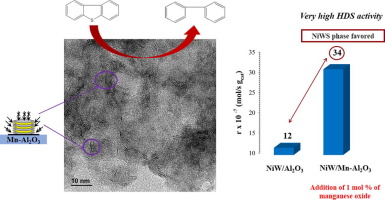Journal of Catalysis ( IF 6.5 ) Pub Date : 2017-09-09 , DOI: 10.1016/j.jcat.2017.08.027 Acela López-Benítez , Gilles Berhault , Laurence Burel , Alfredo Guevara-Lara

|
A series of new NiW catalysts supported on manganese-containing sol-gel alumina for dibenzothiophene hydrodesulfurization (HDS) application was evaluated in the present study. The manganese amount was varied in the support in a 0.1–2.0 mol% range (as MnO). After impregnation, the catalysts were dried at 120 °C for 4 h, calcined at 400 °C for 4 h, and finally sulfided using a 10 mol% H2S in H2 mixture at 400 °C for 4 h. The resulting sulfided NiW/Mn-Al2O3 catalysts were evaluated in the hydrodesulfurization of dibenzothiophene (DBT) at T = 300 °C and P = 30 bars.
During the preparation process, catalysts were characterized after each important step: after drying, after calcination, and finally after sulfidation. Results show that the manganese concentration influences the type of supported Ni-polyoxotungstate deposited on the support. For NiW catalysts supported on 0.1 and 0.5 mol% of MnO, the main tungsten oxide species present are WO42− and W12O408− species, respectively. Increasing the Mn content to 1 mol% of MnO leads to a mixture of polyoxotungstates that favors the formation of an intrinsically highly active promoted NiWS phase after sulfidation. Increasing further the Mn amount to 2 mol% of MnO results in the formation of WO3 clusters and of Mn3+ species reacting with Ni to form a NiMnO spinel phase. This leads to deleted HDS activity for the corresponding NiW catalyst after sulfidation. Finally, results emphasize the beneficial role of manganese since its addition allows to synthetize higher active NiW catalysts for dibenzothiophene hydrodesulfurization than when using the alumina support only.
中文翻译:

Sol-Gel Mn-Al 2 O 3负载的新型NiW加氢脱硫催化剂
在本研究中,评估了负载在含锰的溶胶-凝胶氧化铝上用于二苯并噻吩加氢脱硫(HDS)应用的一系列新型NiW催化剂。载体中的锰含量在0.1-2.0 mol%范围内变化(以MnO计)。浸渍后,将催化剂在120°C下干燥4 h,在400°C下煅烧4 h,最后在400°C下使用10 mol%H 2 S的H 2混合物进行硫化4 h。在T = 300°C和P = 30 bar的条件下,对二苯并噻吩(DBT)进行加氢脱硫,评估所得的硫化NiW / Mn-Al 2 O 3催化剂。
在制备过程中,催化剂的每个重要步骤均经过表征:干燥后,煅烧后以及最终硫化后。结果表明,锰浓度影响沉积在载体上的负载型Ni-聚氧钨酸盐的类型。对于负载在0.1和0.5 mol%的MnO上的NiW催化剂,存在的主要氧化钨物质分别为WO 4 2-和W 12 O 40 8-。将Mn含量增加至MnO的1mol%导致聚氧钨酸盐的混合物,该混合物有利于在硫化后形成本质上高活性的促进的NiWS相的形成。将Mn进一步增加至MnO的2mol%导致形成WO 3团簇和Mn 3+物种与Ni反应形成NiMnO尖晶石相。这导致硫化后相应的NiW催化剂的HDS活性降低。最后,结果强调了锰的有益作用,因为与仅使用氧化铝载体相比,添加锰可以合成用于二苯并噻吩加氢脱硫的更高活性的NiW催化剂。











































 京公网安备 11010802027423号
京公网安备 11010802027423号